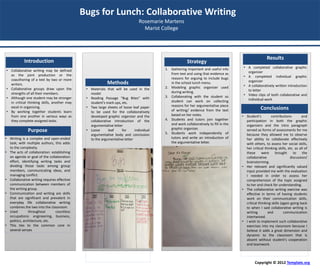More Related Content
Similar to 2013 Collaborative Writing Poster
Similar to 2013 Collaborative Writing Poster (20)
2013 Collaborative Writing Poster
- 1. Bugs for Lunch: Collaborative Writing
Rosemarie Martens
Marist College
Introduction
• Collaborative writing may be defined
as the joint production or the
coauthoring of a text by two or more
writers.
• Collaborative groups draw upon the
strengths of all their members.
• Although one student may be stronger
in critical thinking skills, another may
excel in organizing.
• By working together students learn
from one another in various ways as
they complete assigned tasks.
Purpose
• Writing is a complex and open-ended
task; with multiple authors, this adds
to the complexity.
• The acts of collaboration: establishing
an agenda or goal of the collaboration
effort, identifying writing tasks and
dividing those tasks among group
members, communicating ideas, and
managing conflict.
• Collaborative writing requires effective
communication between members of
the writing group.
• Communication and writing are skills
that are significant and prevalent in
everyday life collaborative writing
combines the two into the classroom.
• Used throughout countless
occupations: engineering, business,
politics, architecture, etc.
• This ties to the common core in
several senses
Methods
• Materials that will be used in the
model
• Reading Passage “Bug Bites” with
student’s mark ups, etc.
• Two large sheets of loose leaf paper
to be used for the collaboratively
developed graphic organizer and the
collaborative introduction of the
argumentative letter
• Loose leaf for individual
argumentative body and conclusion
to the argumentative letter
Results
• A completed collaborative graphic
organizer
• A completed individual graphic
organizer
• A collaboratively written introduction
to letter
• Video clips of both collaborative and
individual work
Strategy
1. Gathering important and useful info
from text and using that evidence as
reasons for arguing to include bugs
in the school lunch menu.
2. Modeling graphic organizer used
during writing.
3. Collaborating with the student so
student can work on collecting
reasons for her argumentative piece
of writing/ evidence from the text
based on her notes.
4. Students and tutors join together
and work collaboratively to fill in the
graphic organizer.
5. Students work independently of
tutors and write an introduction of
the argumentative letter.
Conclusions
• Student's contributions and
participation in both the graphic
organizers and the intro paragraph
served as forms of assessments for me
because they allowed me to observe
her ability to collaborate effectively
with others, to assess her social skills,
her critical thinking skills, etc. as all of
these were brought to the
collaborative discussion/
brainstorming.
• Her relevant and significantly valued
input provided me with the evaluation
I needed in order to assess her
comprehension of the topic assigned
to her and check for understanding.
• The collaborative writing exercise was
effective in terms of having students
work on their communication skills,
critical thinking skills (again going back
to when I said collaborative writing is
writing and communication
intertwined.
• I wish to implement such collaborative
exercises into my classroom because I
believe it adds a great dimension and
dynamic to the classroom that is
absent without student's cooperation
and teamwork.
Copyright © 2012 Template.org
